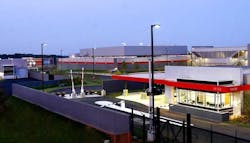Today we continue our Data Center Executive Roundtable, a quarterly feature showcasing the insights of thought leaders on the state of the data center industry, and where it is headed. In today’s discussion, our panel of experienced data center executives – Jeff Klaus of Intel DCM, David Knapp of Chatsworth Products, Sean Icara from Digital Realty, and Vertiv’s Gary Niederpruem – will discuss the ongoing consolidation in the industry, the potential for additional M&A activity, and what it means for the data center sector.
The conversation is moderated by Rich Miller, the founder and editor of Data Center Frontier.
JEFF KLAUS of Intel
Data Center Frontier: There have been a lot of merger and acquisition (M&A) activity recently in the data center industry. How are these M&A deals influencing the development of the data center industry? Are we likely to see more M&A activity?
Jeff Klaus: Absolutely. We will continue will see more M&A activity as this market moves to help more sophisticated customers find services.
Innovations need to be captured and consolidated to present customers with a more cohesive pallet of offerings. Some of those offerings have been with us for a very long time; others are new and need time to mature and fully integrate so they can help address both on-premise and off-premise decisions.
GARY NIEDERPRUEM of Vertiv
Gary Niederpruem: There typically are two inflection points in any industry when M&A occurs. One is early on, when it’s unclear which technology or model will emerge in the market, and companies acquire or merge with others to hedge their bets. The other time is when the industry is more mature, the market has been established, and a company is trying to grow. It can be difficult in that environment to grow organically, so they often choose to grow inorganically through acquisition.
The data center industry has been around for a while, but the advent of cloud computing, colocation, virtualization, the Internet of Things, software-defined networks and so many other emerging trends, the industry has in no way reached a state of maturity. It’s in constant change. That makes it fertile ground for M&A activity, and we’re seeing that among colocation companies and technology providers, among others.
However, because the industry is some 30 years old, we’re also seeing M&A activity consistent with a more established industry – companies seeking growth through geographic expansion, customer expansion or technology acquisition. While the volume of M&A activity in the data center industry isn’t as large as some other industries, I would expect it to continue along those two paths.
DAVID KNAPP of Chatsworth Products
David Knapp: Yes, M&A activity will continue. Although, recent reporting may indicate M&A has slowed in the first quarter of 2017, it still valued in the tens of billions monthly, and acquisitions are paying well. It is a good time to be developing a service, providing a service or offering data center space.
Organizations are making adjustments to focus on their core competencies and shedding technologies that are less profitable than they may have been in the past. On the facilities and hardware side, best practices have reduced the amount of power and cooling equipment needed per floor space. Compute can endure much tougher environmental conditions. Volume servers keep getting more powerful. Virtualization and software defined networks get much more out of each device. On the software side, startups are developing many new, useful applications that can integrate into and improve the feature set of “IT as a service.”
Because of this service boom, enterprises are not building as many data centers, but rather looking to colocation or the cloud. This results in manufacturers improving and consolidating hardware solutions with acquisitions or divestiture; mult-itenant operators are expanding with acquisition to accommodate the demand enterprises have for “IT as a service”; cloud providers are improving services with acquisition and integration of software startups.
SEAN IRACA, Digital Realty
Sean Iraca: There used to be more of a straightforward demarcation between providers’ wholesale versus retail services, but as a result of customer requirements and buying behaviors, those lines are becoming blurred. We are seeing the need for a more diverse and robust portfolio that allow customers to scale and grow over time, future proofing their IT infrastructure. Through this consolidation, data center providers now have the ability to fulfill customer needs from small footprints, even single cabinets, all the way up to multi-megawatt deployments.
Data center consolidation and migration to the cloud will continue to gain ground throughout 2017 and beyond. As we consolidate our global footprint and bring together our traditional scale offering with our highly interconnected sites throughout the world, Digital Realty is well positioned to capture the continued growth driven by cloud, IoT and mobility.
It is estimated that 5 billion devices will be connected by low power wide area networks by 2022. That is expected to drive 4.7 times more traffic than the average 4G connection. With this, businesses will have to re-architect to support the processing and storage needs either with cloud providers or in 3rd party data centers such as ours. Access to networks and other providers will be key along with the ability to scale at the Edge.
NEXT: A look at the trends in data center tools
Keep pace with the fact-moving world of data centers and cloud computing by following us on Twitter and Facebook, connecting with me on LinkedIn, and signing up for our weekly newspaper using the form below:
About the Author



